
The Poisoned Pharmacist
(written by Dr. Les Crocker, Emeritus Professor of Art History)
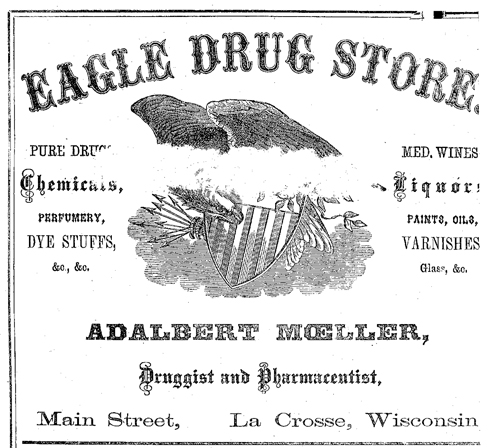
Image of Adalbert Moeller's drug store ad in the 1866 La Crosse city directory
Adalbert Moeller was one of the early settlers in La Crosse, but we know little about him. According to his gravestone, he was from Hertogtum, Coburg-Gothe which was a dutchy in Saxony, later Thuringia, and Moeller was consul at La Crosse for that nation. Why Saxony had a consul in the young town is not known. The 1881 History of La Crosse County states that Moeller was a musical director and singer in the German cultural Liederkranz Society in 1857.
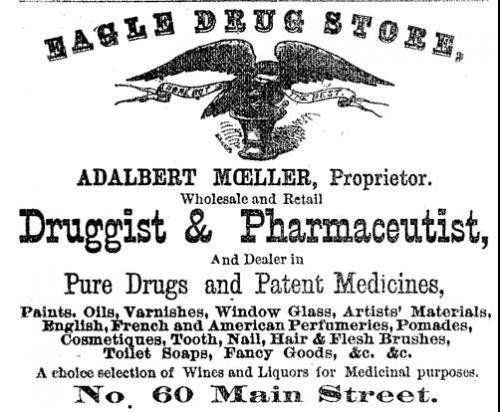
Image of Adalbert Moeller's drug store ad in the 1866 La Crosse city directory
He appears in the first La Crosse city directory of 1866 as a druggist and pharmaceutist [sic] located at the Eagle Drug Store on the south side of Main between 3rd and 4th streets. In the 1868 directory, he lists himself as “Eagle Drug Store, A. Moeller prop., No. 60 Main Street. Apothecary and Chemist, Dealer in Drugs, Patent Medicines, Fancy Goods, Perfumery Travelers' Consolation &c., No. 60, Main.”
He was active in the local Masonic Lodge, was a member of the Liederkranz Society, the Board of Trade, and the Odd Fellows. Moeller was also involved in the First German Evangelical Lutheran Congregation and drew up the church constitution. He served as president of the congregation, and was elected president of the building committee for a new church in 1866. In the spring of 1867 the foundation was laid; in 1868 the outside constructed, and in 1869 the interior was finished.
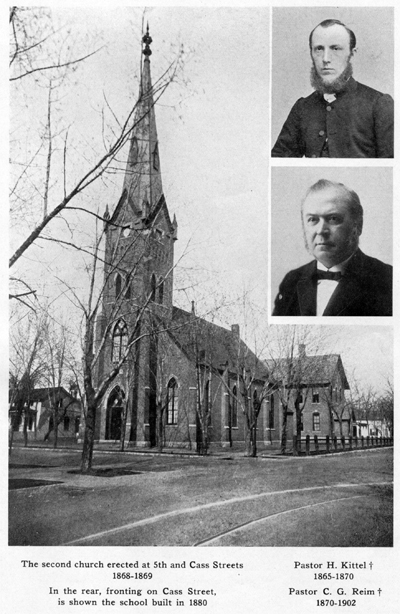
Image of the second First [German] Evangelical Lutheran Church at Cass Street and 5th Avenue from their 1934 anniversary history booklet. Moeller was president of the building committee and likely wielded considerable influence over the design.
In August of 1855 several German residents of the new town organized the first social society in the community, other than church and lodge societies. The Turn Verein, their chartered name which means gymnastic society, endorsed physical activity and gymnastic training for men and later for both boys and girls. There were no drugs to cure disease at this time so physical health was the best defense against illness.
Not to be outdone by their more athletic countrymen, several young Germans started the Maennerchor in 1856 to promote singing and theatrical productions. Often gymnastic exhibitions were combined with choral numbers in their public presentations as the groups supported each other.
In February of 1857 the name was changed to the Liederkranz (wreath of songs) Society, probably to broaden its membership. At first, the group occupied a hall in the Levy and Kellogg block on Pearl Street, but they had larger ambitions. In 1861 the group bought lots on the alley facing north on King Street between Third and Fourth and built Singer Hall.

Singers Hall footprint in the 1884 Sanborn Fire Insurance Map. Singers Hall was located on King Street between 3rd and 4th streets.
A newspaper article in 1861 says the design was by Adalbert Moeller. The building was 90 by 85 feet, thirty feet high, and had a large wing on each side. It had a piazza, what we would call a colonnaded courtyard, with large pillars in front. The wings contained parlors, dining rooms and wardrobe rooms.
The main hall was 50 x 40 with a large gallery and was lighted with skylights, a very unusual feature at this date. The stage was to be 50 x 25, with a cost projected to be $4,000, a considerable sum at the time.
This was a large and dramatic building, especially in a town only a decade old. The Germans may have been on the edge of civilization but that didn’t mean they were uncivilized. They created their own music, dance, opera and theater, as well as literary societies, to lighten the isolation of the wilderness that lay all around them.
Adalbert Moeller must have had a broad range of skills since the description of the Singers Hall indicates a very sophisticated building for the time and not something we would attribute to a pharmacist. Early settlers in a new town are often interesting because of their breadth of skills and abilities. Of course, necessity often requires such breadth.
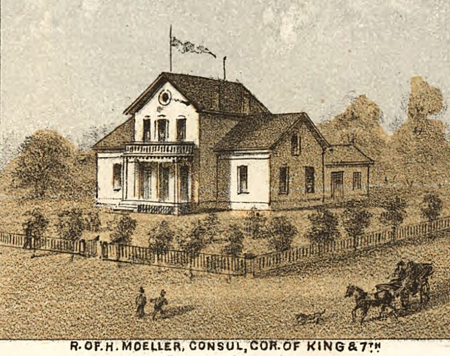
Adalbert Moeller house, located at the northeast corner of 7th & King streets, as depicted in the 1867 bird's eye view of La Crosse
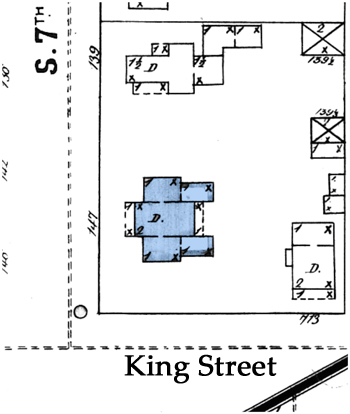
The Moeller house footprint from the 1891 Sanborn Fire Insurance Map
The Moeller's original house was on the northeast corner of 7th and King streets, now demolished, and we have no image of it other than this engraving from the 1867 birds eye map.
Moeller paid taxes on two lots on 7th Street in 1864 and built his house in 1865-1867. The design is taken from The Modern Builder’s Guide by Minard Lafever, first published in 1833 with several later editions.

Minard Lafever's design from "The Modern Builders Guide"
Lafever's temple front house was the source for the Rublee-Washburn-Jenks House at 612 Ferry street built in 1856. Moeller's version is actually closer to Lafever's design because the main block of the house is three bays wide, as opposed to the two-bay front of the Rublee house, and he uses a porch on the two-story section.
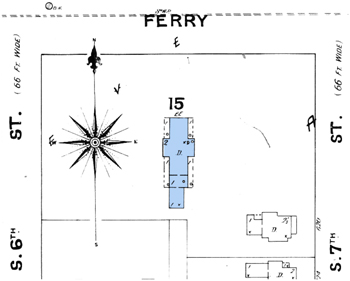
The Rublee-Washburn-Jenks house footprint from the 1891 Sanborn Fire Insurance Map
This raises an interesting point. Was Moeller looking at the Lafever design rather than copying and changing the Rublee house? The description of Moeller's design for Singers Hall, a tall central section with wings on each side and large pillars in front, is even closer to the Lafever design since the Rublee house did not have front columns. Moeller may have had Lafever's book himself or relied on a local contractor who had the book to help in the design or the mysterious Mr. Gregory who designed the Rublee house may have been the designer.
Moeller was a recognized businessman and community leader when the disastrous accident that took his life occurred. According to the newspaper account August, a young worker, had a toothache and had used a little aconite mixed with brandy as a pain killer and left the bottle on the counter. Moeller drank the mix thinking it was brandy. He soon realized what had happened and took an emetic. He walked back to his home on Seventh Street and called a doctor, but he was dead in two hours. Ironically his house was decorated for his birthday party the next day. He was buried on July 8, 1868, 38 years old.
In May 1875 Mina Moeller, Adalbert’s widow, married Louis Runckel, another druggist, and they lived at the Moeller home at the corner of King and 7th streets. But she is buried in Oak Grove alongside her first husband and children.
Aconitine, also known as monkshood or wolfsbane, is a perennial herb often grown as an ornamental plant due to its attractive blue to dark purple flowers. All parts of the plant, especially the roots, contain toxins. Aconitine is the most dangerous of these toxins. It is most noted as a heart poison but is also a potent nerve poison.
Medicine at this time in the United States was quite primitive and considerably behind what was happening in Europe. The Civil War advanced the surgeon's art since amputation was the only treatment for severely damaged limbs but there were few medicines for disease. Quinine was used for malaria and Calomel (mercurous chloride) was used for diarrhea. Morphine, cocaine, chloroform, and ether were used for pain relief but there were few drugs as we think of them.
There were many so called 'patent medicines' available locally or by mail; Moeller's directory listing for 1868 mentions them. Usually they were grain alcohol with a few herbs for color or flavor. Herbal medicines had no standards and there was no government body to regulate these so-called medicines. Any benefit from them was either a placebo effect or a lift from the alcohol content. Neither of which could have helped Moeller.
